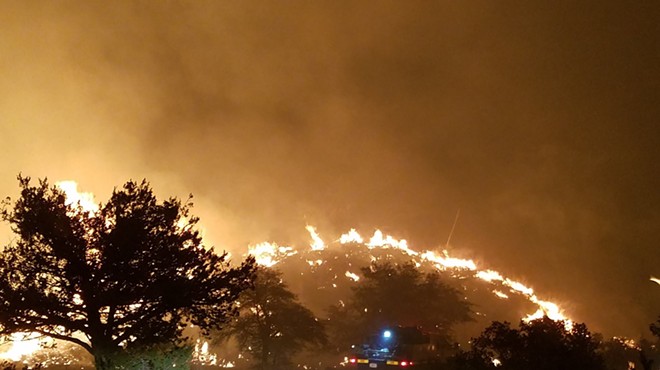Friday, August 14, 2015
Zona Politics with Jim Nintzel: Outer Space with Chris Impey and Beneath Ancient Lakes with Andrew Cohen
Zona Politics Eps.37 from Zona Politics with Jim Nintzel on Vimeo.
This week on Zona Politics with Jim Nintzel: We go into outer space with author Chris Impey and deep beneath ancient African lakes with Dr. Andrew Cohen. Impey, the deputy head of the UA Astronomy Department, stops by talk about his new book Beyond: Our Future in Space, as well as dark matter, the possibility of life on other planets and much more. Then Cohen, a UA professor of geology and ecology and evolutionary biology, discusses his work in ancient African lake beds. You can learn more about Cohen's work, including how the samples he's retrieving are helping scientists understand the world our ancient ancestors lived in, here and you can watch A Human Climate below.Watch Zona Politics at 8 a.m. Sunday on the CW Tucson, Channel 8 on Cox and Comcast and Channel 58 on broadcast, DirecTV and Dish networks.
Here's a transcript of the show:
Hello, everyone. I’m Tucson Weekly senior writer Jim Nintzel and this is Zona Politics. Today, we’re taking a break from public affairs to learn a litle bit about life in outer space. Joining me is author and astronomy, Dr. Chris Impey. Dr. Impey is the deputy head of the U of a Astronomy Department and the author of several books. The most recent is “Beyond: Our Future in Space.” Dr. Impey, welcome to Zona Politics.
(Impey) Nice to be with you, Jim.
(Nintzel) Talk a little bit about what “Beyond” is all about.
(Impey) Well, I sort of felt that most people saw the space program was in the doldrums. You know, Americans can’t put an astronaut in orbit and it’s 40 years plus since we’ve been to the moon. You know the average person thinks it isn’t really happening. But, meanwhile, the private sector is gearing up and there are some pretty exciting things happening, so I felt it was time to sort of look at the space program and our future in space.
(Nintzel) How much longer before we see more people going up in space?
(Impey) Well, we’re still in the tricky experimental phase, and we’ve seen some significant setbacks for Elon Musk and for Orbital Sciences and for Richard Brandt and all in the last year so we know that it’s hard. So putting people back up in orbit is going to be hard, but you know, more than a dozen private space programs are under way, and most of them are looking to put people up there at some point although some are only doing cargo for now, so I think it’s going to be three to five years and then we’ll start seeing quite a lot of astronauts.
(Nintzel) And that’s, and you expect more, private sector, commercialization, essentially of space.
(Impey) Yeah, NASA’s smart and they’re partnering with the private sector. They know they can’t do it on their own with a stagnant budget and too many commitments, so, the private, you know these are billionaires with a lot of money to burn, and we haven’t even heard from some of them. Jeff Bezos, Blue Origin, that’s the most secretive of the private space companies and he’s got awfully deep pockets, so, yeah, I think the money from the private sector could dwarf what NASA can bring to the table.
(Nintzel) And you mentioned that people may not be aware of some of the stuff that’s going on, but NASA’s got a pretty interesting program with the U of A with the OSIRIS REx project.
(Impey) Yeah, and so they’re still doing some great stuff, and I think NASA are caught in this same conundrum that existed in the space program for decades, which is you know, robots, like OSIRIS Rex, that can take you to the edge of the solar system they’re cheaper. You don’t have to worry about people and looking after the people and keeping them safe, but people inspire most of us. The idea of humans in space doing interesting exciting things, being explorers–that’s inspirational. So, if you only did it with robots, I don’t think the general public would be that interested. The scientists would love it. They get a lot of bang for the buck.
(Nintzel) And you talk about the dangers of people in space. I was talking with Mark Kelly, the retired astronaut, about what goes on with people’s bodies in space. We’re really not designed for zero gravity, are we?
(Impey) Not at all, and most of the astronauts who spend a year or more in orbit, and that’s more than a dozen, have had health problems when they came down. Of course we’re looking at this great control experiment of the twins: one twin up there for a year, and one twin down on Earth.
(Nintzel) Mark’s brother up there in the International Space Station.
(Impey) So there are problems, and just now project those forward to a situation where you’re on another planet for years or perhaps the rest of your life, or you form a colony and you start to have children and grandchildren born in a different environment, and humans are going to change if that ever happens.
(Nintzel) What about the question of sex in space, and some special challenges?
(Impey) It’s continually denied by both NASA and the Russians, and the Russian counterparts. The scuttlebut is that, yeah, it probably has happened and we just don’t know about it. Astronauts are pretty good at keeping secrets. I mean, yeah, it’s going to happen, and think of (it as) a landmark. Now that we’ve had the first person in space, the first woman, the first spacewalk, the first baby born in space? The first human born off-Earth? That would be an extraordinary landmark in human history
(Nintzel) You’ve said if the U.S. Government were more generous with NASA we might be a lot further along with space colonization right now. Where do you think we’d be?
(Impey) I think we could have had a moon and a Mars colony. We could have an off-Earth activity that that’s quite significant. NASA’s budget is roughly $18 billion and in real terms it’s sort of been declining for a decade or more. And they’re in a tough part of the budget, vying with Veterans Affairs and Social Security. They’re kind of a minnow in that part of the budget, so they’re never going to get that much more money. And a lot of their science is involved with looking at the Earth, taking care of the Earth and monitoring the Earth, so not everything they do is about outer space. So once you take what’s left, there’s propulsion, development or the shuttle program or the International Space Station, you know, you’re not talking about many billions of dollars.
(Nintzel) What do you make of the Pluto footage we’re getting back these days?
(Impey) It’s extraordinary. Most people, even some planetary scientists, anticipated Pluto should be fairly dull. I mean it’s smaller than the moon. The moon is geologically dead. It was peppered with craters, nothing going on, not much atmosphere. But Pluto is much more exciting than the moon, and it shouldn’t be by all measures, so we have a big old mystery on our hands, because the surface being as young as it is, compared to, say, the moon, which had this old, geologically old surface, is a huge mystery. Where’s the heat coming from that’s been driving that activity, creating the ice mound and re-surfacing that small dwarf planet. And we simply don’t know. It’s really exciting.
(Nintzel) Is it a planet, or is it not a planet?
(Impey) Astronomers are cold, hard-hearted and they voted and they’re not going back on that. They’re calling it a dwarf planet, and logically, since we found at least one, and potentially five or six outer solar-system worlds as big or bigger than Pluto, you either are going to have to take Pluto off the table or make school children memorize five or six new planet-names, so I think actually it’s a gentler way to go.
(Nintzel) The “dwarf planet.” You wrote a book called “Humble Before the Void,” and it’s about teaching science to Tibetan monks How did that all come about?
(Impey) Just a call out of the blue from a young post-doc who himself was tapped by the head of a Tibetan library, who was the Dalai Lama’s translator for ten years, to start up a program to teach Buddhist monks. It’s spurred by the Dalai Lama’s intense interest in science, which he’s had for decades, and he’s worried that Tibetan culture will become a museum piece. They don’t have a homeland. He’s also worried about the monastic training for his monks and nuns, which goes back hundreds of years. He wants there to be science and technology and math in the curriculum, so I got imported with some other western instructors to run workshops and teach monks and nuns pretty much every year. I’m going back in October.
(Nintzel) And how engaged are they?
(Impey) They’re incredible. I mean they’re perhaps less well-trained in math and physics and science than a sixth or seventh grader, but they’ve been through a decade of monastic training. Their thought processes, their logic, their rhetoric, their philosophy are extremely sharp. They’re intellectually right on it, and, of course, they’re incredibly curious and they bring a lightness to the classroom, you know, a sense of fun and humor that just makes it a joy to teach.
(Nintzel) What did you take away from the experience?
(Impey) Well, I sort of recast how I taught my subject. Going there knowing it was extraordinary, I pretty much threw away all my notes and my Powerpointa and just started from scratch. And that was helpful, to be able to approach your own subject from scratch. And I brought some of that new approach back into the classroom at the U of A.
(Nintzel) You study some very weird stuff out there. The super-massive black holes. What is a super-massive black holes?
(Impey) It’s just a beefier version of the black hole that’s left when a massive star dies. Those are conventional black holes. They’re just condensed objects, so dense that not even light can escape left when massive stars die. And they’re just a few times the mass of the sun. But nature knows how to make black holes a lot bigger than that. There’s one that’s four million times the mass of the sun at the center of our own galaxy, and the ones I study are much farther away in other galaxies, and they go up to four or five billion times the mass of the sun, which is pretty extraordinary. It’s a black hole that’s nine orders of magnitude than the death of a single star.
(Nintzel) Where do they come from or do we know?
(Impey) We think that every galaxy has one. That’s an important discovery of the last few decades. They’re not oddball galaxies with black holes. Essentially every galaxy has one including our own. We think the centers of galaxies are dense regions anyway, with piled up piles of stars, and over time a little seed black hole, maybe ten billion years ago it was only a hundred times the mass of the sun, will just gradually chow down on gas and dust and maybe complete stars, swallowed whole, and over billions of years, a little seed black hole can grow to a behemoth, a beast that’s millions or billions of times the mass of the sun.
(Nintzel) And they play a big role in helping gravity hold the galaxy together?
(Impey) Actually it’s a good question but they don’t. The mass of black holes in galaxies are typically .1 percent, one part in a thousand of the mass of the galaxy, so they don’t dominate the mass of the galaxy but they sure dominate what happens in the center. And when they’re active — our galaxy’s black hole is kind of quiet, which is why we didn’t know it was there for a long time — when they’re booming, when they’re eating, they are intensely visible, so the black hole can outshine the galaxy it sits in by a factor of a hundred a thousand.
(Nintzel) What do we know about dark matter?
(Impey) Not enough! It’s been one of the big mysteries of the universe, because for every particle, you know, proton, neutron, electron, in our bodies or in all the stars in the universe, there seem to be about six or seven times as many of these dark matter particles. So it dominates the mass of the universe, and, at the moment, we’re kind of mystified as to what dark matter is. But we do think it’s a fundamental particle. It’s not rocks in space or things that didn’t quite turn into stars, or dust particles. It’s something fundamental. Some new part of physics.
(Nintzel) What is one of the weirdest things about how the universe works?
(Impey) Well, I think you’ve alluded to the dark matter as one of them but the universe has three major ingredients. It has normal stuff that we’re made of, and planets and stars and galaxies. It has dark matter, and it has dark energy. The dark matter is holding the big things together and the dark energy is forcing the universe to expand faster and faster and those last two ingredients, the dark matter and the dark energy are 95% of the universe. So the stuff we truly understand well and have classified well is five percent. So that is pretty bizarre, to live in a universe that you generally think you understand fairly well in terms of laws of physics while the two biggest ingredients, the bulk of the material of the universe, are still mysterious to us.
(Nintzel) Are we going to find life out there someime soon?
(Impey) I think so, I hope so in my lifetime. The work on exoplanets is just going gangbusters. Twenty years ago there were zero planets known beyond the solar system. None. And the number goes up every day. It’s probably about 4, 000 that we now know. And a couple hundred of those are Earth-like, and maybe a fraction of those are habitable and Earth-like, so we’re projecting 20 billion habitable and Earth-like worlds in just the Milky Way galaxy, and the odds that they’re all dead I think are very low.
(Nintzel) Life is a pretty persistent force, at least on this planet.
(Impey) You would think so. It formed on the Earth four billion years ago when the Earth was a pretty nasty place, and it’s persisted and pervaded the Earth so, yeah most people think if the ingredients there and you’ve got a lot of time and the conditions are right then, yeah, it should happen.
(Nintzel) What got you interested in astronomy?
(Impey) I got into it through physics. Astronomers are sort of formed two ways. Either they’re the kids with the telescopes and the dark night sky, growing up and trading up for bigger telescopes, but I grew up in London and New York and cities. I didn’t see any stars growing up. The other route is through physics, where essentially astronomy is applying the laws of physics out into the universe. So that was my first degree, and that’s how I got into it.
(Nintzel) You teach science at the U of A. Are you concerned about scientific illiteracy?
(Impey) Absolutely. It’s a big issue because we have all these, not in my field, but, in general, all these big technical issues that are front and center, whether it’s climate change or genetic engineering, or what to do with the space program, and you know, in a civil, democratic society, if people don’t understand the issues a little bit at the technical level, or they’re at least informed then these decisions are going to be made by people who don’t understand them, or by people who have a different agenda (that’s) not technically informed, so I think it’s a big concern. It’s a concern of mine. I sort of measure science literacy among U of A undergrads. It’s a little disconcerting the things they do and don’t know when they graduate.
(Nintzel) What do you like about teaching?
(Impey) Oh the dynamic aspect of it. The fact that you don’t know what to expect. Some of my colleagues get a little annoyed that every year their students seem to get younger and younger, but I like it because the energy of 18 and 17-year-olds in your classroom, even if it’s a little chaotic sometimes, it’s great. You know the best questions they ask, the fact that they don’t have pre-conceived notions, the fact that they sometimes want to rock the boat a little, challenge the conventional wisdom–that’s great. That’s sort of how science has progressed over the years. So they bring that raw energy into the classroom.
(Nintzel) Alright. We’re going to have to leave it there, but thank you very much for joining us here on Zona Politics. We’ll be right back with Dr. Andrew Cohen to talk about some of his work in Africa.
(Nintzel) Joining us now is Dr. Edward Cohen, who is a professor of geosciences and ecology and evolutionary biology at the U of A. Dr. Cohen is using drilling equipment to extract core samples that can be used to look backwards into time to discover more about our ancient ancestors, climate change, and more. Dr. Cohen welcome to Zona Politics.
(Cohen) Thanks, Jim.
(Nintzel) You spend about a month every year over in Africa drilling down into these ancient lake beds and pulling up core samples for study. You’re trying to find out more about ancient man and climate change. Tell us a little bit about this.
(Cohen) Yeah, well, climate history is a big part of what we try to do in collecting these records. Lake beds, you can think of them like tree rings. They give us an archive of our history that’s very detailed, and we’ve been doing this kind of work for a long time trying to understand environmental change and climate change as we get longer and longer records, it became obvious that we could start to ask questions about the environmental context and the situations that existed during the time of our early ancestors and other species related to our own species, Homo sapiens. And so this project developed after a number of other successful deeper and deeper drilling projects into the African lakes the cradle of humankind, where we realized this was really a golden opportunity to really understand where we came from and what the conditions were at the time that we evolved.
(Nintzel) and why are these lakes the place to do this?
(Cohen) The African Rift Lakes are a treasure trove for understanding our history. They’re very old. They owe their existence to the rifting process of the Earth’s great tectonic plates. They’re pulling apart there, separating the African continent. That process has been going on for millions of years, creating a huge rift valley through East Africa, and as that process goes on, water and sediment has collected at the bottom of the valley producing these large lakes, and all the material that’s being washed in from the watersheds around the lakes. So there’s an archive that’s been developing there over millions of years, and unlike, say, our own Great Lakes in the Midwest and the United States, which are relatively recent features, dating back by geological terms, relatively recently, still old maybe ten thousand, 15 thousand years ago, whereas these lakes go back millions of years, and so, they give us a time frame and a context that’s about the same as that of human origins, six million years or so.
(Nintzel) So that’s about how far back you go…
(Cohen) At the time of the split as we understand it today, between our own lineage, the hominins, and those of the African great ape, the chimps and gorillas.
(Nintzel) And somewhere along the line we didn’t just have the Homo sapiens, but other hominins that went extinct. What do we know about our ancient cousins?
(Cohen) Well, there are perhaps ten or more different species that have been documented. It depends on who you listen to or believe, but certainly there’s a wide diversity of earlier species of hominins, and they’re all extinct of course today except for us, but they had many different forms. Some of them walked upright, would have looked quite similar to us. Some of them had a lot of transitional features from our common ancestors with chimps and gorillas that would have either lived on the ground or at times may have retreated to trees early on in their ancestry. Some of them had large brains like us, especially in the recent past. Others, much smaller, much more like a great ape. As we look through time, some of them, the early species, especially of our own close relatives in the genus homo, were capable of producing stone tools and over time we see a transition in the technologies, evolution of the ability of people to manipulate their environment, to use fire, so brain size, our upright stature, our diet, all of these things change, and we see differences between different species.
(Nintzel) And climate change had a probably a role in this as well. As we saw fewer trees and more grasslands and that’s why perhaps we didn’t spend as much time in trees.
(Cohen) Well, that’s certainly one of the ideas that’s out there We can’t claim to know precisely what was driving each individual step or branch of human evolution, but certainly the general sense is that the environment and particularly climate played a big role in the evolution of individual species, their success and ultimately the extinction of individual species as well. Climate conditions improved for certain species. The population sizes may have increased. They may have had adaptive advantages, and other species that were doing different things in that area may have lost out, so we see a waxing and waning of different species.
(Nintzel) What do you find in these samples, in these core samples and what does it tell you about the environmental conditions.
(Cohen) Well, to people in my field, my specialty is called paleo limnology, so limnology is the study of lakes, and paleo means old, so we study the sediments and the fossils that are found in these lake cores. You can think of these as big cylinders of mud that are extracted from the bottom of the lake, and we go further and further down as we push these drills, these tubes further down into the bottom of the lake. We can take out of them the fossils of small organisms that lived in the water. We can take out of them the pollen from trees and plants that were growing around the watershed, telling us something about vegetation. We find charcoal in them, which tells us about the history of fire. People have been using and manipulating fire in East Africa for longer than anyplace else in the world as far as we know, and we potentially can look at that record. We can also extract from the core materials that allow us to date (items) because of course just knowing that something happened is not as interesting as knowing when it happened, and so from the context of trying to relate these records to what was (happening) on land with the early people, we want to be able to accurately date them. So dating, looking at the chemistry, looking at the fossils Specialist groups do all of these different things, and by no means is it all going on in my lab. We’re working with many, many different labs to analyze the samples.
(Nintzel) And you’ve been in this business for a long time. Talk a little bit about how just the drilling technology has changed, and how do these rigs work.
(Cohen) Well, the rigs that we use, if you’ve seen an oil field rig in Texas or Louisiana or someplace, these are much smaller. They’re more similar to what would be used in a mine. And they’re special rigs that are designed to allow us to collect core samples. So these are, again, tubes of material. We’re not just trying to make a hole in the ground, and we certainly are not trying to find oil and gas. In fact that would be kind of a disaster if we did, so we actively avoid places where oil and gas may be found. We’re trying to collect continuous records, and to do that, we need some specialized not so much the drilling tools, but the sampling tools that have been designed to allow scientists to collect these cores in as pristine and intact condition as possible. That’s really important. A lot of the technology developments have gone into perfecting how we get out better and better core samples more and more.
(Nintzel) You’ve had some hairy moments over in Africa. Talk about some of the geopolitical challenges of working there.
(Cohen) Well I should say first of all that I’ve really enjoyed the 35 plus years that I’ve worked in Africa. It’s been a privilege to work in that continent in many different countries. Having said that, certainly there have been times of a little bit of turmoil. We were working for many years in the country of Burundi and in the ’90s we had to pull out of there very quickly when the wars broke out in Burundi and Rwanda, move our operation to Tanzania a little bit to the south. You’re constantly trying to deal with, thread the needle around, local political conditions, and often it’s not so much the national politics but just the very local politics of dealing when you bring a big drilling rig into an area, you’re quite conspicuous, and people are wondering what you do what you’re doing, and they want to know are you the first thing anyone asks, “Are you looking for gold, are you looking for gold? Are you looking for oil or whatever? So a lot of our politics is on a very local level, trying to convince people that we’re not doing that. And that we’re actually trying to document their heritage. We’ve spent a lot of time on outreach locally and not just in the U.S. but in local African communities and in ? trying to spread the word of what we’re doing, build up museum capacity locally and really keep people informed of the science of the findings that are coming out. It’s an important treasure for the local people there.
(Nintzel) And you have a film about your work that was recently produced, and talk a little bit about the film and how that came about.
(Cohen) Yeah the film was a collaboration and ongoing thing between me and the filmmaker, who is a company called Earth Images Foundation, a non-profit in Oakland, California. When we started putting together the drilling proposal, I had contacted them. I knew the filmmaker and I said I would really like to build in, as an integral part of the outreach effort of this project, doing a film of the drilling activity and the science behind it. So we were able to get funding from the National Science Foundation through their education and outreach offices to document not only the drilling phase but also going into the labs and looking at what was going on with the sample collection. Really, one of the exciting things about the film was that we were able to get into the actual fossil hominin vaults at the national museums of Kenya and Ethiopia, so a lot of the skeletons and skulls that you see in the film are the real thing. And you see a picture of Turkana Boy (Nariokotome Boy) or, hopefully, in the upcoming film we’ll have footage of Lucy. These are the real fossil skeletons that are, you know, people may have seen on tour. Lucy was on tour around the United States a year or two or go. People (were) paying a lot of money to go and see it. Our filmmaker was able to get in there and film in 3D, and it really brings out the nature of these fossils when you can actually see them that way.
(Nintzel) And we have a clip from that. Let’s take a look.
(Music soundtrack)
(Narrator) Of the more than ten human species that once lived on our planet, all but Homo sapiens have gone extinct. Some of them probably because they failed to adapt to climate change.
(Cohen) All of those other species have gone extinct. What were the conditions that caused those extinctions? Were they climatic? Those are important questions, and ones that have implications for understanding of our own adaptability.
(Narrator) Learning precisely how environmental changes affected human evolution is crucial for us today as we currently experience what may be the fastest-changing climate in all of human history
(Dr. Zeray Alemseget, Chair of the Anthropology Department at the California Academy of Sciences) Even though we are a young species, only 400,000 years old, the contribution to the climate change and the environmental change that we are bringing about is unprecedented. The good news is that we also happen to be a species with the brain capacity that allows us not only to transform the environment, but also to comprehend what it means what it entails. So if we were to transform our environment in a sustainable fashion, that will give us a better chance of surviving into the future.
(Nintzel) Very interesting film clip there. So thank you very much for coming down here and talking about your work.
(Cohen) Thank you, and thank you for your interest.
(Nintzel) And that is our show for today. I would like to think Dr. Andy Cohen for coming to visit us. as well as Dr. Fritz Impey and our sponsors of course over at the Arizona Inn and Hotel Congress, and our media partners at the Tucson Hispanic Chamber of Commerce. If you missed any part of today’s episode, you can catch up with us at zonapolitics.com and follow us on Facebook. Thanks for watching. We’ll see you next time.
Tags: Zona Politics with Jim Nintzel , Chris Impey , Andrew Cohen , A Human Climate , Beyond: Our Future in Space , Arizona science , Arizona news , Tucson news , Video


















